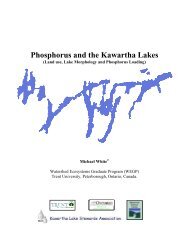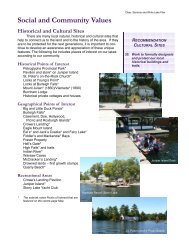Lake Water Quality 2006 Report - Lakefield Herald
Lake Water Quality 2006 Report - Lakefield Herald
Lake Water Quality 2006 Report - Lakefield Herald
You also want an ePaper? Increase the reach of your titles
YUMPU automatically turns print PDFs into web optimized ePapers that Google loves.
Appendix E: Basic Rationale for E.coli Testingand <strong>Lake</strong>-by-<strong>Lake</strong> ResultsChoosing sitesThe goals of this testing were threefold:• to see how safe the water was for swimming at these sites• to provide baseline data for ongoing monitoring in future years• to discover sources of elevated bacterial countsAlmost all sites were chosen because it was thought that they would have the highestE.coli counts in the lake; that is, we were “looking for trouble”. Therefore, pleaserealize that the readings shown here do not represent the average bacterial levels onour lakes; rather, they would represent some of the highest bacterial levels on ourlakes. Test sites included:• Areas of high use (resorts, live-aboard docking areas, etc.)• Areas of low circulation (quiet, protected bays)• Areas near inflows (from culverts, streams, wetlands)• Areas of concentrated populations of wildlife (near wetlands, areas popularwith waterfowl)Please note:• KLSA does not test drinking water. Only surface waters are tested. All untreated surfacewaters are considered unsafe for drinking.• KLSA results are valid only for the times and locations tested, and are no guarantee that alake will be safe to swim in at all times and in all locations.Why did we test for E.coli?E.coli was the bacteria of choice because:• The presence of E.coli indicates fecal contamination from warm-bloodedanimals such as birds or mammals, including humans. It is not found, forinstance, on rotting vegetation. The presence of E.coli indicates the possiblepresence of other disease-causing organisms found in fecal material, such asthose causing gastrointestinal and outer ear infections.• E.coli is present in fecal material in very high numbers. Healthy humans excreteabout 100 million E.coli per ¼ teaspoon of fecal matter! Therefore, it is easierto “find” than most other less plentiful bacteria.• E.coli itself can be dangerous. Although most strains of E.coli are harmless,some strains cause serious disease, such as in the Walkerton tragedy, oroccasionally in ground beef “scares.” The basic analysis done by SGS <strong>Lake</strong>fieldResearch cannot distinguish the difference between the harmless and thedeadly, so we always treat E.coli as if we were dealing with a harmful strain.67





